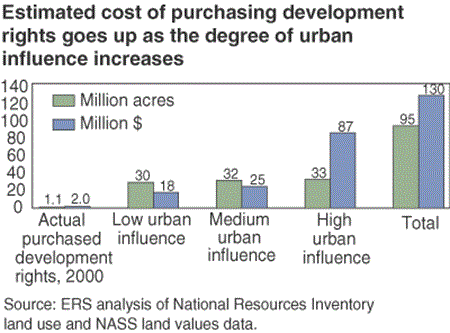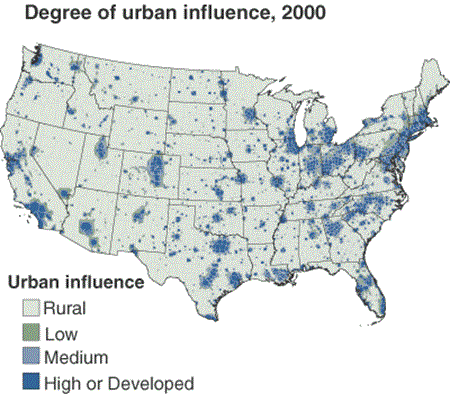Greenbelts? Not Without Greenbacks

In the last 30 years, the urbanized area in the United States has more than doubled to 3 percent of all land, with over a third coming from cropland and pasture. ERS estimates that 95 million acres of cropland—about one-fifth of the U.S. total—is subject to varying degrees of development pressure, or urban influence. Potential for continued development has spurred efforts to protect farmland and its many benefits—agricultural production, rural lifestyles, wildlife habitat, rural vistas, and open space.
Policymakers have turned to two types of voluntary farmland protection programs to create incentives for farmland owners to keep their land undeveloped. Concerns about private property rights and the difficulties of enacting local land use regulations have made voluntary farmland protection programs more attractive than mandatory means. Through preferential property tax assessment, authorized in all States, landowners’ annual property taxes are computed based on the land’s agricultural value, rather than on the higher value if it were developed. In effect, State and local governments are sacrificing tax revenue to reduce the landowner’s incentive to develop the land. Because of preferential assessment, States annually forgo taxes valued at $1.1 billion, with a current value over future years of $27 billion. But much of the land receiving preferential taxation is eventually developed anyway, and some land receiving tax breaks is never at real risk of development.
A second approach, purchase of development rights (PDRs), legally restricts the owner’s ability to develop the land. The landowner is paid a lump sum—equal to the difference between the agricultural and developed property value—to forever give up development rights. PDR programs protected 1.1 million U.S. acres as of 2002 at a cost of $2 billion, according to the American Farmland Trust. ERS estimates that it would cost $130 billion to purchase the development rights on all cropland subject to development pressure across the U.S., about 65 times more than has been spent to date. However, not all of the cropland near urban areas is subject to equal development pressure. If the 30 million acres of cropland under the least pressure were protected through PDRs to create a greenbelt around future development, the cost would be only $18 billion (about $600/acre on average). In contrast, if the 33 million cropland acres under high pressure were protected through PDRs, the program would cost $87 billion (about $2,600/acre on average). Comparing these PDR cost estimates illustrates the substantial tradeoff between using available funds for saving more acres under less development pressure versus saving the fewer acres that are under more immediate pressure for development.
There is also a tradeoff between PDRs and preferential assessment programs. Instead of “spending” the equivalent of $27 billion on preferential property tax assessment to temporarily protect farmland in the path of development, spending the money in PDR programs instead could permanently protect much of the cropland currently subject to low and medium development pressure across the U.S. This would put greenbacks into true greenbelts.
Development at the Urban Fringe and Beyond: Impacts on Agriculture and Rural Land, by Ralph Heimlich and William Anderson, USDA, Economic Research Service, June 2001
Farmland Protection: The Role of Public Preferences for Rural Amenities, by Daniel Hellerstein, Cynthia Nickerson, Joseph Cooper, Peter Feather, Dwight Gadsby, Daniel Mullarkey, Abebayehu Tegene, and Charles Barnard, USDA, Economic Research Service, April 2005



